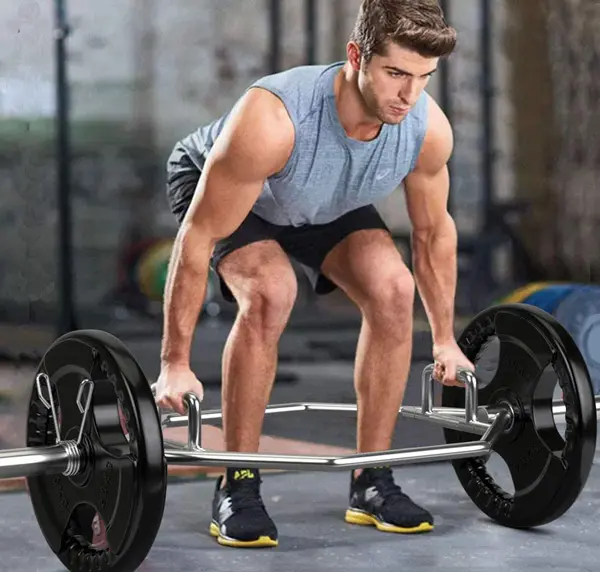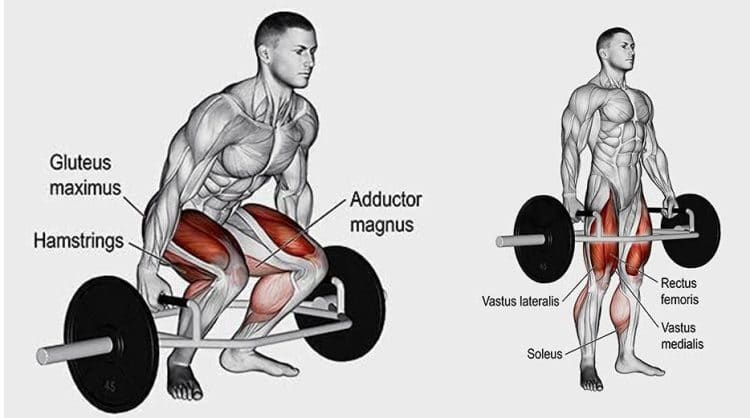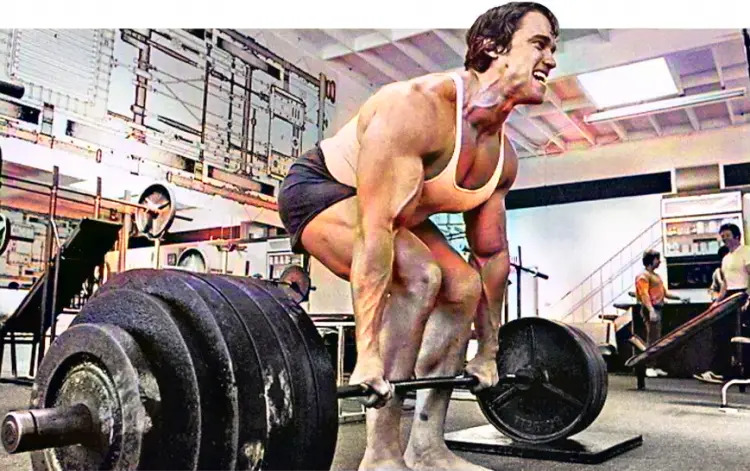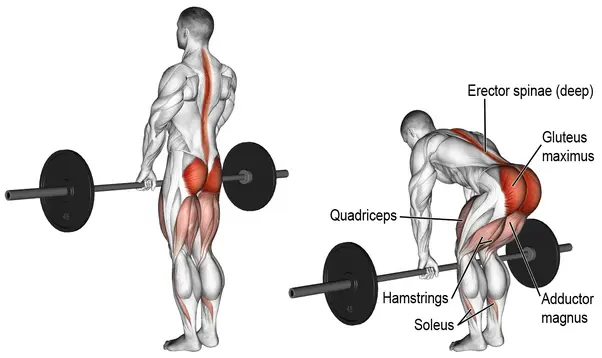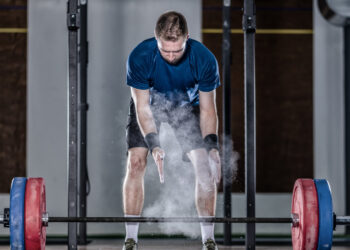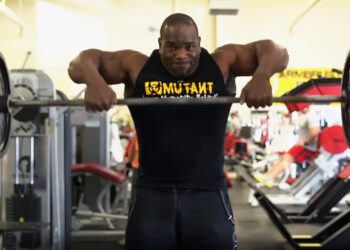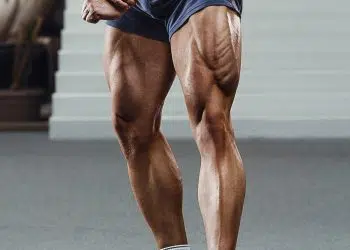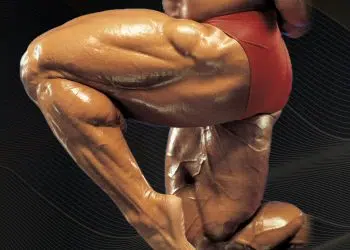It’s hard to think of an exercise that’s more important than deadlifts. Yes, the squat is the so-called king of exercises, and Bench Press Day happens every Monday in most gyms, but the deadlift has them both beat!
Firstly, deadlifts teach you how to lift heavy objects off the floor without hurting yourself, i.e., using your legs and without rounding your lower back. This is an essential skill both in and out of the gym. A deadlift is often the starting point for other exercises, such as barbell biceps curls and bent over rows. After all, you’ve got to pick the weight up somehow, so you might as well do it safely.
Secondly, when it comes to building muscle, deadlifts are tough to beat. They involve almost every muscle in the body and are especially good for beefing up your posterior chain, which is the collective name for your hamstrings, glutes, and back muscles. If you want a bigger, more muscular back, deadlifts are a must. Bodybuilders usually do deadlifts as part of their back workouts.
You can even use deadlifts to lose weight and get lean. They’re metabolically demanding and because they’re a full-body exercise, doing deadlifts burns a lot of calories.
Finally, the deadlift is a tremendous strength exercise. It’s part of powerlifting and strongman competitions, and athletes from all sports use deadlifts to get stronger.
There are several different deadlift variations you can use to reach your training goals. In this article, we’re going to compare and contrast trap bar and conventional barbell deadlifts to determine if one is better than the other.
Level Up Your Fitness: Join our 💪 strong community in Fitness Volt Newsletter. Get daily inspiration, expert-backed workouts, nutrition tips, the latest in strength sports, and the support you need to reach your goals. Subscribe for free!
Trap Bar Deadlift 101
Trap bars, also known as hex bars and Gerard bars, have a diamond-shaped frame that allows you to stand between two parallel handles. They were invented in the 1980s by American powerlifting champion Al Gerard. Gerard often suffered from back pain, and, at times, his back was so bad he could not do conventional deadlifts.
Out of desperation, Gerard tried doing deadlifts with two 100-pound dumbbells instead of a barbell. He found that having the weights next to him rather than in front took a lot of stress off his lower back. Inspired by this discovery, he designed a frame that he could use instead of the unwieldy dumbbells, and the Gerard bar was born.
Trap bars can be used for a range of lower body and upper body exercises, but it’s most commonly used for deadlifts.
Muscles Worked
Trap bar deadlifts are a compound exercise. That means they involve multiple joints and muscles working together. Trap bar deadlifts are virtually a full-body exercise. However, the main muscles trained during trap bar deadlifts are:
- Quadriceps – front of the thigh
- Hamstrings – back of the thigh
- Gluteus maximus – back of hip
- Erector spinae – lower back
- Core – midsection/abs
- Latissimus dorsi – side of upper back
- Trapezius – mid and upper back
- Deltoids – shoulders
- Biceps and triceps – upper arms
- Forearms – gripping muscles
How to do trap bar deadlifts
- With the trap bar on the floor, stand between the handles. Ideally, the handles should be around nine inches above the floor. Using bumper plates should ensure this. Some trap bars have raised handles, so you don’t have to bend over so far, which is handy when using small diameter weight plates.
- Position your feet, so they’re between shoulder and hip-distance apart. Your stance may be determined by the size and design of the trap bar you are using. Squat down and grab the handles so your hands are facing inward.
- Straighten your arms, lift your chest, and lower your hips. Pull your shoulders down and back and brace your core. Your lumbar spine should be slightly arched.
- Without bending your arms or rounding your lower back, drive your feet into the floor and stand up straight. Do not lean back at the top or attempt to bend your arms, as this could result in injury.
- Reverse the movement and lower the bar back down to the floor. Reset your position and repeat it.
Trap Bar Deadlift – Pros
Not sure if trap bar deadlifts are the best exercise for your goals? Consider these pros:
Less low back strain – trap bar deadlifts position the weight on either side of your feet instead of in front of them. This stops you from being pulled forward, as can happen with conventional barbell deadlifts. Having the weight in line with your feet reduces stress on your lower back. Remember, Al Gerard invented the trap bar to provide a back-friendly way to deadlift!
Less risk of biceps injury – if you deadlift with a straight bar, you may use a mixed grip to stop the bar from rolling out of your fingers. This puts a lot of stress on the biceps of the supinated arm. Biceps tears are common with lifters who use a mixed grip.
No more scraped shins – powerlifters wear long socks to protect their shins from the bar during conventional barbell deadlifts. With the bar nowhere near your shins, you won’t have to worry about grazing your legs when doing trap bar deadlifts.
More quad-centric workout – where conventional deadlifts are very posterior chain dominant, trap bar deadlifts involve more quads activation (1). Because of this, some people actually call trap bar deadlifts squat lifts. If you want to work your quads but don’t want to do squats, trap bar deadlifts could be a good solution. And, unlike barbell squats, you can do trap bars to failure, as you won’t get stapled under a heavy weight.
Easier to learn – trap bar deadlifts are more forgiving and easier to learn than conventional deadlifts. The set position of the handles means that beginners are more likely to adopt the correct position with minimal instruction. Barbell deadlifts are more technically demanding and easier to do incorrectly.
Trap Bar Deadlift – Cons
You need a trap bar – not all gyms have trap bars, and they can be expensive to buy. While you can simulate this exercise using two dumbbells or kettlebells, they will probably knock against your legs. If you want to do trap bar deadlifts, you’re going to need a trap bar.
Less posterior chain engagement – if you want to build the muscles on the back of your body, trap bars may not be the best exercise for you. They’re more like a squat than a conventional barbell deadlift. At the very least, if you do trap bar deadlifts, you’ll probably need to supplement your workout with something like Romanian deadlifts to ensure that you develop the back of your legs, too.
Not powerlifting specific – despite being invented by a powerlifter, trap bar deadlifts are not a recognized part of powerlifting. If you want to train for powerlifting, conventional barbell deadlifts should be your main focus. However, in strongman, competitors often do parallel grip deadlifts, such as during the car lift and at the start of the farmer’s or frame walk. As such, it may be a valuable exercise for strongman competitors.
Not ideal for all lifters – most trap bars feature fixed-width handles. If you are shorter or taller than average, you may find trap bar deadlifts uncomfortable or impractical. For example, the width of your stance will be limited by the space between the handles and the dimensions of the frame.
Barbell Deadlift 101
The barbell deadlift is an iconic strength training exercise. It is so-called because each rep starts with the weight resting on the floor – it’s a “dead” weight. The deadlift is the final test of strength in powerlifting competitions and often features in strongman events, too. Bodybuilders do deadlifts to build a wider, thicker back.
There are two main types of barbell deadlift – conventional stance and sumo stance. The former is done with a hip to shoulder-width foot position, while the latter is done with feet wide apart.
In Victorian times, the deadlift was called the health lift, which should give you an idea of how beneficial this exercise can be. Almost every exerciser should do some form of deadlifts; they’re THAT important.
Muscles Worked
Like trap bar deadlifts, barbell deadlifts are a compound exercise involving multiple joints and muscles working together. The main muscles trained during trap bar deadlifts are:
Level Up Your Fitness: Join our 💪 strong community in Fitness Volt Newsletter. Get daily inspiration, expert-backed workouts, nutrition tips, the latest in strength sports, and the support you need to reach your goals. Subscribe for free!
- Hamstrings – back of the thigh
- Gluteus maximus – back of hip
- Erector spinae – lower back
- Quadriceps – front of the thigh
- Core – midsection/abs
- Latissimus dorsi – side of upper back
- Trapezius – mid and upper back
- Deltoids – shoulders
- Biceps and triceps – upper arms
- Forearms – gripping muscles
Barbell deadlifts involve more hip flexion and less knee flexion than trap bar deadlifts. As such, there is less quadriceps and more posterior chain engagement.
How to do barbell deadlifts
- Set your barbell, so it’s nine inches above the floor. Using bumper plates usually does this automatically.
- Stand with your toes under the bar, feet about hip to shoulder-width apart.
- Reach down and grip the bar with an overhand or mixed grip.
- Straighten your arms, pull your shoulders down and back, and brace your abs. Your hips should be below your shoulders, and your lower back slightly arched.
- Without bending your arms or rounding your lower back, drive your feet into the floor and stand up.
- Do not lean back at the top or attempt or bend your elbows, as this can cause serious injury.
- Push your hips back, bend your knees, and lower the bar back to the floor.
- Let the weight settle for a second or two, and then repeat. Do not bounce the bar off the floor.
Read more about deadlifting with perfect form here.
Barbell Deadlift – Pros
There are several reasons that conventional deadlifts deserve a place in your workouts, including:
Accessible – all you need to do conventional deadlifts is a barbell and some weight plates. You can also do deadlifts using dumbbells, or even a heavy rock, backpack, or similar. Subsequently, whether you train at home or in a gym with limited equipment available, you should be able to include deadlifts in your workouts.
Build a bigger back – compared to trap bar deadlifts, barbell deadlifts are better for adding mass to your upper and lower back. Lat pulldowns, pull-ups, and bent-over rows are all effective back exercises, but they mainly focus on your lats.
Barbell deadlifts work every muscle on the back of your body, from the nape of your neck to your heels. If you want a big, powerful back, conventional deadlifts will help. Trap bar deadlifts are much more lower-body dominant.
A full-body workout – the barbell deadlift trains almost every muscle in your upper and lower body. There aren’t many exercises that train more muscles at the same time. As such, barbell deadlifts are a very time-efficient exercise. Combine them with something like bench presses, dips, or overhead presses, and you really can train your entire body with just two exercises.
Barbell Deadlift – Cons
Like every exercise, there are drawbacks to doing barbell deadlifts, too:
Risk of back injury – starting each rep with the weight on the floor in front of you puts a lot of stress on your lower back. The risk of back injury increases exponentially if you round your lumbar spine. Tall lifters, people with poor hamstring flexibility, and those with a weak core are prone to rounding their lower backs during conventional deadlifts.
Trap bar deadlifts allow you to maintain a more upright torso, potentially reducing lower back stress. They’re easier on your biceps, too, which are easily injured when using a mixed grip.
Trap Bar Deadlift vs. Barbell Deadlift
So, now that you know a little more about trap bar deadlifts and barbell deadlifts, let’s judge these exercises by a few different criteria:
Trap bar deadlift vs. Barbell deadlift: Strength
Strength is specific to the type of exercise you perform. If you want to barbell deadlift more weight, you need to focus mainly on that exercise. Conversely, if you want to trap bar deadlift heavier loads, doing more trap bar deadlifts is the way to go. While there is some crossover between these two exercises, you should spend more time and energy on the one you want to improve.
Trap bar deadlift vs. Barbell deadlift: Hypertrophy
Despite appearances to the contrary, the trap bar deadlift and barbell deadlift emphasize different muscles. Trap bar deadlifts are more knee/quadriceps dominant, while barbell deadlifts work your hips and back more. Both exercises can build muscle, but you need to choose the movement that best targets the muscles you want to work. Think of trap bar deadlifts as being more akin to squats.
Trap bar deadlift vs. Barbell deadlift: Safety
Trap bar deadlifts allow you to keep your torso more upright than barbell deadlifts, taking stress off your lumbar spine in the process. Trap bar deadlifts are also an excellent alternative to barbell squats, and you can safely do them without a squat rack. They also place less stress on your biceps.
While barbell deadlifts are not necessarily a dangerous exercise, it’s clear that, for some people, the trap bar deadlift is safer.
Trap bar deadlift vs. Barbell deadlift: Ease of learning
Barbell deadlifts can be tricky to learn. Your stance and grip need to be correct and, with the weight in front of your feet, you need to know how to hip hinge and maintain a neutral spine to avoid lower back pain or injury.
In contrast, trap bar deadlifts are more straightforward, and things like hand position and stance are dictated by the design of the bar. Just stand with your feet between your hands and grab the handles; much simpler!
As such, most exercisers will find trap bar deadlifts easier to learn than barbell deadlifts.
Trap bar deadlift vs. Barbell deadlift: Availability
Almost every gym on the planet has barbells and weight plates, which is all you need to do conventional deadlifts. Trap bars are not uncommon, but not all gyms have them. You can buy your own, but good-quality trap bars can be expensive. So, in terms of equipment and, therefore, exercise availability, you are more likely to have access to what you need to do barbell deadlifts.
Trap bar deadlift vs. Barbell deadlift: Variety
One of the best ways to avoid progress plateaus is to change your workout from time to time and use variations of your main exercises. There are lots of ways to modify barbell deadlifts to maintain progress and ward off boredom. Good options include:
- Deficit deadlifts – standing on 4 to 6” platform to increase range of motion
- Deadlifts with chains or bands – to increase load as you approach lockout
- Paused deadlifts – pause with the bar at knee height for 2-5 seconds
- Speed deadlifts – use 50% of your 1RM and lift the bar as fast as you can
Plus, there are lots of barbell deadlift variations you can do:
- Partial deadlift
- Rack pull
- Paused deadlift
- Reeves deadlift
- Romanian deadlift
- Snatch grip deadlift
- Stiff leg deadlift
While you can do things like deficit, paused, and Romanian deadlifts with a trap bar, there are more variations and modifications for conventional barbell deadlifts. Also, you can use a barbell for more exercises in general than a trap bar. If you have to choose between a barbell or a trap bar and want to do the largest possible range of exercises, a standard barbell is best.
Related:
Wrapping Up
While they look similar, trap bar deadlifts and barbell deadlifts are actually quite different exercises. The best way to look at trap bar deadlifts is as a type of squat with your arms down by your sides. They involve more quadriceps engagement, and you can keep your torso more upright, taking stress off your lower back.
In contrast, barbell deadlifts require more hip flexion, and you have to lean forward more to do them. This increases posterior chain engagement and means that barbell deadlifts are more of a back than a leg exercise.
Both exercises are very effective and can build strength and muscle mass. However, each one affects your body differently, so you should choose the one that best matches your training goal.
Still can’t decide between trap bar and barbell deadlifts? Do them both! Put trap bar deadlifts in your leg workouts and do barbell deadlifts on back day. That way you can enjoy all the benefits of these great exercises.
References:
1 – PubMed: Electromyographic Comparison of Barbell Deadlift, Hex Bar Deadlift, and Hip Thrust Exercises: A Crossover Study https://pubmed.ncbi.nlm.nih.gov/28151780/
Interested in measuring your progress? Check out our strength standards for Bench Press, Stiff Leg Deadlift, Barbell Curl, and more.

